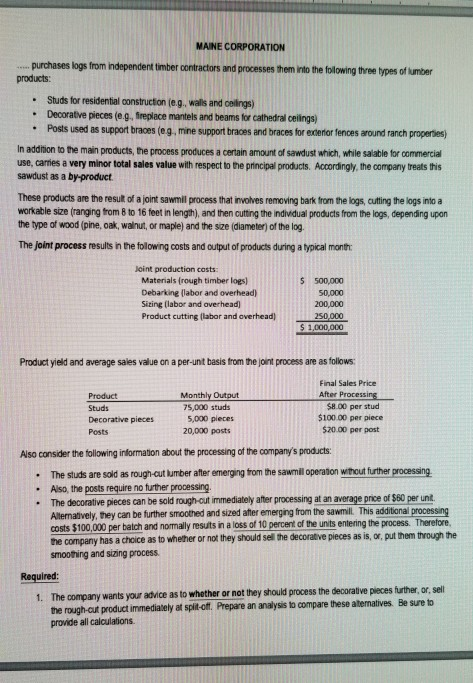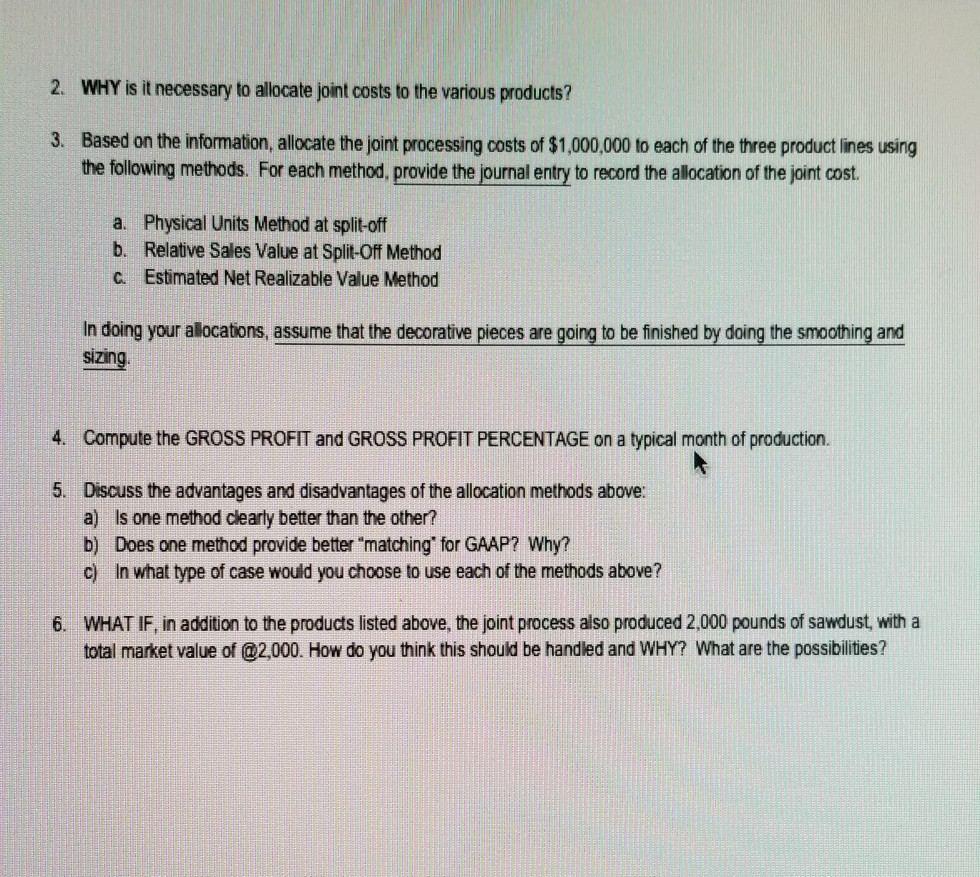Answered step by step
Verified Expert Solution
Question
1 Approved Answer
If you can aswers all, that would be perfect if not, please answer 1 thru 4. Thanks. MAINE CORPORATION purchases logs from independent timber contractors


If you can aswers all, that would be perfect if not, please answer 1 thru 4.
Thanks.

MAINE CORPORATION purchases logs from independent timber contractors and processes them into the foilowing three types of lumber products: ..p Studs for residental constuction e.g. wells and colng) Decoratve pieces (eg, freplace mantels and beams for cathedral ceilings) Posts used as support braces (eg, mine support braces and braces for exterior fences around ranch properties) In addition to the main products, the process produces a certain amount of sawdust which, while saiable for commercial use, carnies a very minor total sales value with respect to the principal products. Accordingly, the company treats this sawdust as a by-product These products are the result of a joint sawmil process that involves removing bark from the logs, cutting the logs into a workable size (ranging from 8 to 16 feet in length), and then cutting the individual products from the logs, depending upon the type of wood (pine, oak, walnut, or maple) and the size (diameter) of the log The joint process results in the following costs and output of products during a typical month Joint production costs Materials (rough timber loes) Debarking (labor and overhead) Siting (labor and averhead Product cutting labor and overhead) $ 500,000 50,000 200,000 250,000 - $ 1,000,000 Product yield and average sales value on a per-unt basis from the joint process are as folows: Final Sales Price After Process Studs Decorative pieces Posts Monthly Output 75,000 studs 5,000 pleces $8.00 per stud 5100.00 per piece 520.00 per post 20,000 posts Also consider the tollowing information about the processing of the company's products . The studs are sold as rough-cut lumber after emerging from the sawmill operaon without further processing .Also, the posts require no further processing . The decorative pieces can be sold rough-out immediately ater processing at an average price of $80 per unt Alematively, hey can be further smoothed and sized afher emerging from the sawmill This additional processing costs $100,000 per betch and nomally resuts in a loss of 10 percent of the unts entering the process. Theretore the company has a choice as to whether or not they should sell the decorative pieces as is, or, put them through the smoothing and sizing process Required The company wants your advice as to whether or not they should process the decrative pieces further, or, se the rough-cut product immediaiely at split of. Prepare an analysis t compare these aternatives. Be sure to provide all calculations 1. 2. WHY is it necessary to allocate joint costs to the various products? 3. Based on the information, allocate the joint processing costs of $1,000,000 to each of the three product lines using the following methods. For each method, provide the journal entry to record the allocation of the joint cost. a. b. c. Physical Units Method at split-off Relative Sales Value at Split-Off Method Estimated Net Realizable Value Method In doing your allocations, assume that the decorative pieces are going to be finished by doing the smoothing and sizing 4. Compute the GROSS PROFIT and GROSS PROFIT PERCENTAGE on a typical month of production. 5. Discuss the advantages and disadvantages of the allocation methods above: a) is one method clearly better than the other? b) Does one method provide better "matching' for GAAP? Why? c) In what type of case would you choose to use each of the methods above? WHAT IF, in addition to the products listed above, the joint process also produced 2,000 pounds of sawdust, with a total market value of @2,000. How do you think this should be handled and WHY? What are the possibilities? 6. Allocation of Joint Costs: Reading Chapter 7 LO5- You can ignore the weighted average method. MAINE CORPORATION NOTE: For allocating joint costs, you certainly COULD do the standard 5-step process and develop a rate and then multiply. However, you can also do these with just percentages as is demonstrated in the book. Because of the purposes of joint cost allocation, the "rate" really has no significance on its own so, accordingly, we will be doing this the way it is shown in the text - by figuring the percent to allocate to each product and multiplying
Step by Step Solution
There are 3 Steps involved in it
Step: 1

Get Instant Access to Expert-Tailored Solutions
See step-by-step solutions with expert insights and AI powered tools for academic success
Step: 2

Step: 3

Ace Your Homework with AI
Get the answers you need in no time with our AI-driven, step-by-step assistance
Get Started


